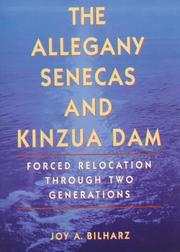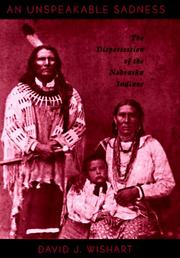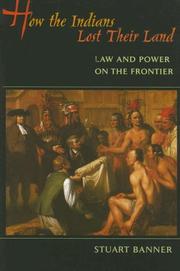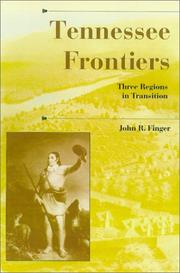| Listing 1 - 8 of 8 |
Sort by
|
Book
ISBN: 077358336X 9786612867033 0773576592 1282867032 9780773576599 9780773535886 0773535888 9780773535879 077353587X 6612867035 9781282867031 Year: 2009 Publisher: Montréal Ithaca McGill-Queen's University Press
Abstract | Keywords | Export | Availability | Bookmark
 Loading...
Loading...Choose an application
- Reference Manager
- EndNote
- RefWorks (Direct export to RefWorks)
Aboriginal policy and claims negotiation in Canada is seen to be a murky and perplexing world that has become an important public issue and has significant policy implications for government spending. Aboriginal land policy in Canada began as an Aboriginal initiative. In No Place for Fairness, David McNab - a long time advisor on land and treaty rights for both government and First Nations groups - looks at the Bear Island Indigenous rights case, initiated by the Teme-Augama Anishinabe, to explore why governments fail to deal effectively with Aboriginal land claims. The book, divided into two sections, includes a survey of the historical background of the Bear Island claim followed by a more personal series of reflections about what happened as the claim encountered decades of policy hurdles, court cases, public protests, and above all resistance by the Temagami First Nation. McNab provides details of how ministers and their senior officials resisted real efforts to resolve problems as well as examples of field staff resisting government attempts at resolution. He also shows that government entities such as the Indian Commission of Ontario and the Native Affairs Directorate were largely used as "mailboxes" where successive federal and provincial governments sent things they wanted to bury. No Place for Fairness is the story of what happens when Aboriginal peoples' political rights are crammed into the Euro-Canadian legal system. McNab makes a clear case that a legalistic approach to these problems is wholly inadequate and that more important things - like fairness - must be recognized as paramount if a just and lasting Aboriginal land policy is to be created.
Indigenous peoples --- Indian land transfers --- Claims. --- Land tenure --- Government relations.
Book
ISBN: 1442661526 9781442661523 9781442661530 1442661534 9781442644779 9781442612846 144264477X 1442612843 Year: 2013 Publisher: Toronto
Abstract | Keywords | Export | Availability | Bookmark
 Loading...
Loading...Choose an application
- Reference Manager
- EndNote
- RefWorks (Direct export to RefWorks)
This book provides the first systematic and comprehensive analysis of the factors that explain both completed and incomplete treaty negotiations between Aboriginal groups and the federal, provincial, and territorial governments of Canada. Since 1973, groups that have never signed treaties with the Crown have been invited to negotiate what the government calls "comprehensive land claims agreements," otherwise known as modern treaties, which formally transfer jurisdiction, ownership, and title over selected lands to Aboriginal signatories. Despite their importance, not all groups have completed such agreements - a situation that is problematic not only for governments but for Aboriginal groups interested in rebuilding their communities and economies.Using in-depth interviews with Indigenous, federal, provincial, and territorial officials, Christopher Alcantara compares the experiences of four Aboriginal groups: the Kwanlin Dün First Nation (with a completed treaty) and the Kaska Nations (with incomplete negotiations) in Yukon Territory, and the Inuit (completed) and Innu (incomplete) in Newfoundland and Labrador. Based on the experiences of these groups, Alcantara argues that scholars and policymakers need to pay greater attention to the institutional framework governing treaty negotiations and, most importantly, to the active role that Aboriginal groups play in these processes.
Indigenous peoples --- Indian land transfers --- Indians of North America --- Land transfers, Indian --- Land titles --- Aboriginal peoples --- Aborigines --- Adivasis --- Indigenous populations --- Native peoples --- Native races --- Ethnology --- Claims. --- Land tenure --- Government relations. --- Government relations --- Land transfers --- Registration and transfer

ISBN: 0585268479 9780585268477 0803212828 9780803212824 Year: 1998 Publisher: Lincoln : University of Nebraska Press,
Abstract | Keywords | Export | Availability | Bookmark
 Loading...
Loading...Choose an application
- Reference Manager
- EndNote
- RefWorks (Direct export to RefWorks)
In the late 1950s, the U.S. Army Corps of Engineers announced its intention to construct a dam along the Allegheny River in Warren, Pennsylvania. The building of the Kinzua Dam was highly controversial because it flooded one-third of the Allegany Reservation of the Seneca Nation of Indians. Nearly six hundred Senecas were forced to abandon their homes and relocate, despite a 1794 treaty that had guaranteed them those lands in perpetuity. In this revealing study, Joy A. Bilharz examines the shortand long-term consequences of the relocation of the Senecas. Granted unparalleled access to members of the Seneca Nation and reservation records, Bilharz traces the psychological, economic, cultural, and social effects over two generations. The loss of homes and tribal lands was heartwrenching and initially threatened to undermine the foundations of social life and subsistence economy for the Senecas. Over time, however, many Senecas have managed to adapt successfully to relocation, creating new social networks, invigorating their educational system, and becoming more politically involved on local, tribal, and national levels.
Seneca Indians --- Indian land transfers --- Dams --- Gender & Ethnic Studies --- Social Sciences --- Ethnic & Race Studies --- Diversion structures (Hydraulic engineering) --- Earthwork --- Hydraulic structures --- River engineering --- Barrages --- Indians of North America --- Land transfers, Indian --- Land titles --- Iroquois Indians --- Relocation. --- Relocation --- Land transfers --- Registration and transfer --- Kinzua Dam (Pa.) --- Allegheny River Dam (Pa.) --- Dams.

ISBN: 0585326541 9780585326542 0803247745 9780803247741 Year: 1994 Publisher: Lincoln, Neb. University of Nebraska Press
Abstract | Keywords | Export | Availability | Bookmark
 Loading...
Loading...Choose an application
- Reference Manager
- EndNote
- RefWorks (Direct export to RefWorks)
Indians of North America --- Indian land transfers --- Ethnic & Race Studies --- Gender & Ethnic Studies --- Social Sciences --- Land transfers, Indian --- Land titles --- American aborigines --- American Indians --- First Nations (North America) --- Indians of the United States --- Indigenous peoples --- Native Americans --- North American Indians --- Relocation --- Land transfers --- Registration and transfer --- Culture --- Ethnology --- Nebraska --- State of Nebraska --- Nebraska Territory --- History
Book
ISBN: 9781316613696 9781107160644 1316613690 9781316675908 1107160642 1108548776 1108547672 1316675904 Year: 2018 Publisher: Cambridge Cambridge University Press
Abstract | Keywords | Export | Availability | Bookmark
 Loading...
Loading...Choose an application
- Reference Manager
- EndNote
- RefWorks (Direct export to RefWorks)
Allan Greer examines the processes by which forms of land tenure emerged and natives were dispossessed from the sixteenth to the eighteenth centuries in New France (Canada), New Spain (Mexico), and New England. By focusing on land, territory, and property, he deploys the concept of 'property formation' to consider the ways in which Europeans and their Euro-American descendants remade New World space as they laid claim to the continent's resources, extended the reach of empire, and established states and jurisdictions for themselves. Challenging long-held, binary assumptions of property as a single entity, which various groups did or did not possess, Greer highlights the diversity of indigenous and Euro-American property systems in the early modern period. The book's geographic scope, comparative dimension, and placement of indigenous people on an equal plane with Europeans makes it unlike any previous study of early colonization and contact in the Americas.
Indians of North America --- American aborigines --- American Indians --- First Nations (North America) --- Indians of the United States --- Indigenous peoples --- Native Americans --- North American Indians --- Indian inspectors --- Government relations --- Land tenure&delete& --- History --- Culture --- Ethnology --- Government policy --- Land tenure --- Indian land transfers --- History. --- Government relations. --- Land transfers, Indian --- Land titles --- Land transfers --- Registration and transfer
Book
ISBN: 0826355005 9780826355003 1306981018 9781306981019 9780826354990 0826354998 Year: 2014 Publisher: Albuquerque
Abstract | Keywords | Export | Availability | Bookmark
 Loading...
Loading...Choose an application
- Reference Manager
- EndNote
- RefWorks (Direct export to RefWorks)
In this book, the first study of the NCIO, historian Thomas A. Britten traces the workings of the council along with its enduring impact on the lives of indigenous people.
Indian land transfers --- Self-determination, National --- Indians of North America --- National self-determination --- Nationalism --- Nation-state --- Nationalities, Principle of --- Sovereignty --- American aborigines --- American Indians --- First Nations (North America) --- Indians of the United States --- Indigenous peoples --- Native Americans --- North American Indians --- History --- Politics and government --- Government relations --- Culture --- Ethnology --- National Council on Indian Opportunity (U.S.) --- United States. --- History. --- NCIO (National Council on Indian Opportunity) --- National Council of Indian Opportunity (U.S.)

ISBN: 0674020537 9780674020535 067402396X 9780674023963 0674018710 9780674018716 0674018710 9780674018716 Year: 2009 Publisher: Cambridge, MA
Abstract | Keywords | Export | Availability | Bookmark
 Loading...
Loading...Choose an application
- Reference Manager
- EndNote
- RefWorks (Direct export to RefWorks)
Between the early seventeenth century and the early twentieth, nearly all the land in the United States was transferred from American Indians to whites. How did Indians actually lose their land? Stuart Banner argues that neither simple coercion nor simple consent reflects the complicated legal history of land transfers. Instead, time, place, and the balance of power between Indians and settlers decided the outcome of land struggles.
Indians of North America --- Indian land transfers --- Property --- Land tenure --- Agrarian tenure --- Feudal tenure --- Freehold --- Land ownership --- Land question --- Landownership --- Tenure of land --- Land use, Rural --- Real property --- Land, Nationalization of --- Landowners --- Serfdom --- Land transfers, Indian --- Land titles --- Indian inspectors --- Land tenure. --- Legal status, laws, etc. --- Government relations. --- History. --- Law and legislation --- Government policy --- Land transfers --- Registration and transfer --- United States --- Politics and government. --- Race relations. --- Legal status, laws, etc --- Government relations --- History

ISBN: 1282066161 9786612066160 0253108721 9780253108722 0253339855 9780253339850 9781282066168 6612066164 Year: 2001 Publisher: Bloomington Indiana University Press
Abstract | Keywords | Export | Availability | Bookmark
 Loading...
Loading...Choose an application
- Reference Manager
- EndNote
- RefWorks (Direct export to RefWorks)
Indian land transfers --- Indians of North America --- Land settlement --- Pioneers --- Frontier and pioneer life --- Tennessee --- Land transfers, Indian --- Land titles --- American aborigines --- American Indians --- First Nations (North America) --- Indians of the United States --- Indigenous peoples --- Native Americans --- North American Indians --- Resettlement --- Settlement of land --- Colonies --- Land use, Rural --- Human settlements --- First settlers --- Settlers, First --- Persons --- History. --- Land transfers --- Registration and transfer --- Culture --- Ethnology --- State of Tennessee --- Tanasi --- تينيسي --- Tīnīsī --- ولاية تينيسي --- Wilāyat Tīnīsī --- Tennessi --- Штат Тэнесі --- Shtat Tėnesi --- Тэнесі --- Tėnesi --- Тенеси --- Теннесси --- Ténésii Hahoodzo --- Tennessee osariik --- Τενεσί --- Πολιτεία του Τενεσί --- Politeia tou Tenesi --- Estado de Tennessee --- Tenesio --- 테네시 주 --- T'enesi-ju --- 테네시주 --- T'enesiju --- 테네시 --- Kenekī --- טנסי --- מדינת טנסי --- Medinat Ṭenesi --- Tennesia --- Tenesis --- テネシー州 --- Teneshī-shū --- テネシー --- Teneshī --- Tenessì --- Statul Tennessee --- Tennessee suyu --- Tennessee Eyâleti --- Теннессі --- טענעסי --- Tenesės --- 田纳西州 --- Tiannaxi zhou --- 田纳西 --- Tiannaxi --- TN (Tennessee) --- Tenn. --- Franklin (State) --- Territory of the United States, South of the River Ohio --- Ethnic relations. --- Social conditions.
| Listing 1 - 8 of 8 |
Sort by
|

 Search
Search Feedback
Feedback About UniCat
About UniCat  Help
Help News
News